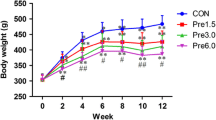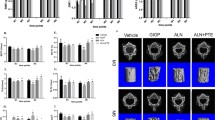Abstract
Glucocorticoids cause secondary osteoporosis, which leads to considerable morbidity from fractures. The antiosteoporosis activity of ellipticine against glucocorticoid-induced osteoporosis in rats was investigated in the present study. Sprague–Dawley rats were used and dexamethasone (2.5 mg/kg) was used to induce osteoporosis, after which the rats were given ellipticine (test sample) and alendronate (positive control) for 20 weeks. Bone turnover, antioxidants, inflammatory cytokines, nutritional parameters, and hormone factors were variables measured. Ellipticine reduced body weight and considerably increased uterine and vaginal weight. Ellipticine dramatically increased trabecular bone number levels while suppressing bone volume fraction, trabecular separation, bone surface fraction, and trabecular thickness. Ellipticine raised circulatory osteocalcin levels while decreasing bone Gla protein, acid phosphatase, alkaline phosphatase, and β-C-terminal telopeptide levels considerably. Ellipticine increased serum malonyl dialdehyde levels while decreasing plasma glutathione, catalase, and superoxide dismutase levels, as well as suppressing inflammatory cytokines. Ellipticine significantly reduced potassium, calcium, 25(OH)vitamin D and magnesium levels and increased estradiol levels while suppressing parathyroid hormone and tartrate-resistant acid phosphatase levels. Ellipticine reduced the level of receptor activator of nuclear factor-kappa B ligand while increasing the level of osteoprotegerin. Docking study demonstrated that ellipticine docked the estrogen receptors (alpha and beta) and VDR (vitamin D receptor). Consequently, ellipticine exhibited antiosteoporosis effects against glucocorticoid-induced loss of bone in rats.
Graphical Abstract








Similar content being viewed by others
Data Availability
The data available on the request to the corresponding author.
References
An L, Shi L, Ye Y, Wu D, Ren G, Han X, Xu G, Yuan G, Du P (2021) Protective effect of Sika Deer bone polypeptide extract on dexamethasone-induced osteoporosis in rats. Electron J Biotechnol 52:52–58. https://doi.org/10.1016/j.ejbt.2021.04.002
Aoki K, Saito H, Itzstein C, Ishiguro M, Shibata T, Blanque R, Mian AH, Takahashi M, Suzuki Y, Yoshimatsu M, Yamaguchi A, Deprez P, Mollat P, Murali R, Ohya K, Horne WC, Baron R (2006) A TNF receptor loop peptide mimic blocks RANK ligand-induced signaling, bone resorption, and bone loss. J Clin Invest 116:1525–1534. https://doi.org/10.1172/JCI22513
Buchet R, Millán JL, Magne D (2013) Multisystemic functions of alkaline phosphatases. Methods Mol Biol 1053:27–51. https://doi.org/10.1007/978-1-62703-562-0_3
Chen Z, Xue J, Shen T, Mu S, Fu Q (2016) Curcumin alleviates glucocorticoid-induced osteoporosis through the regulation of the Wnt signaling pathway. Int J Mol Med 37:329–338. https://doi.org/10.3892/ijmm.2015.2432
Feng M, Zhang R, Gong F, Yang P, Fan L, Ni J, Bi W, Zhang Y, Wang C, Wang K (2014) Protective effects of necrostatin-1 on glucocorticoid-induced osteoporosis in rats. J Steroid Biochem Mol Biol 144:455–462. https://doi.org/10.1016/j.jsbmb.2014.09.005
Feng P, Shu S, Zhao F (2022) Anti-osteoporosis effect of fisetin against ovariectomy induced osteoporosis in rats: in silico, in vitro and in vivo activity. J Oleo Sci 71:105–118. https://doi.org/10.5650/JOS.ESS21252
Föger-Samwald U, Dovjak P, Azizi-Semrad U, Kerschan-Schindl K, Pietschmann P (2020) Osteoporosis: pathophysiology and therapeutic options. EXCLI J 19:1017–1037. https://doi.org/10.17179/excli2020-2591
Ge X, Zhou G (2021) Protective effects of naringin on glucocorticoid-induced osteoporosis through regulating the PI3K/Akt/mTOR signaling pathway. Am J Transl Res 13:6330–6341
Gong T, Su XT, Xia Q, Wang JG (2018) Gentiana macrophylla Pall. (Gentianaceae) extract exerts protective effects against osteoporosis in mice. Trop J Pharm Res 17:429–434. https://doi.org/10.4314/tjpr.v17i3.7
Hou T, Zhang L, Yang X (2019) Ferulic acid, a natural polyphenol, protects against osteoporosis by activating SIRT1 and NF-κB in neonatal rats with glucocorticoid-induced osteoporosis. Biomed Pharmacother 120:109205. https://doi.org/10.1016/j.biopha.2019.109205
Hozayen WG, El-Desouky MA, Soliman HA, Ahmed RR, Khaliefa AK (2016) Antiosteoporotic effect of Petroselinum crispum, Ocimum basilicum and Cichorium intybus L. in glucocorticoid-induced osteoporosis in rats. BMC Complement Altern Med 16:165. https://doi.org/10.1186/s12906-016-1140-y
Huang Q, Gao B, Wang L, Hu YQ, Lu WG, Yang L, Luo ZJ, Liu J (2014) Protective effects of myricitrin against osteoporosis via reducing reactive oxygen species and bone-resorbing cytokines. Toxicol Appl Pharmacol 280:550–560. https://doi.org/10.1016/j.taap.2014.08.004
Johnell O, Kanis JA (2006) An estimate of the worldwide prevalence and disability associated with osteoporotic fractures. Osteoporos Int 17:1726–1733. https://doi.org/10.1007/s00198-006-0172-4
Kamaruzzaman M, Thanu A, Yusof M, Soelaiman I, Ramli E (2019) Kelulut honey ameliorates glucocorticoid induced osteoporosis via its antioxidant activity in rats. Asian Pac J Trop Biomed 9:493–500. https://doi.org/10.4103/2221-1691.271722
Kanis JA, Cooper C, Rizzoli R, Reginster JY (2019) European guidance for the diagnosis and management of osteoporosis in postmenopausal women. Osteoporos Int 30:3–44. https://doi.org/10.1007/s00198-018-4704-5
Kerachian MA, Cournoyer D, Harvey EJ, Chow TY, Bégin LR, Nahal A, Séguin C (2010) New insights into the pathogenesis of glucocorticoid-induced avascular necrosis: microarray analysis of gene expression in a rat model. Arthritis Res Ther 12:R124. https://doi.org/10.1186/ar3062
Kirwan JR (1995) The effect of glucocorticoids on joint destruction in rheumatoid arthritis. N Engl J Med 333:142–147. https://doi.org/10.1056/nejm199507203330302
Lieben L, Carmeliet G (2013) The delicate balance between vitamin D, calcium and bone homeostasis: lessons learned from intestinal-and osteocyte-specific VDR null mice. J Steroid Biochem Mol Biol 136:102–106. https://doi.org/10.1016/j.jsbmb.2012.09.019
Lin S, Huang J, Zheng L, Liu Y, Liu G, Li N, Wang K, Zou L, Wu T, Qin L, Cui L, Li G (2014) Glucocorticoid-induced osteoporosis in growing rats. Calcif Tissue Int 95:362–373. https://doi.org/10.1007/s00223-014-9899-7
Liu S, Yuan X, Ma C, Zhao J, Xiong Z (2020) 1H-NMR-based urinary metabolomic analysis for the preventive effects of gushudan on glucocorticoid-induced osteoporosis rats. Anal Biochem 610:113992. https://doi.org/10.1016/j.ab.2020.113992
Macfarlane E, Seibel MJ, Zhou H (2020) Arthritis and the role of endogenous glucocorticoids. Bone Res 8:33. https://doi.org/10.1038/s41413-020-00112-2
Mo H, Zhang N, Li H, Li F, Pu R (2019) Beneficial effects of Cuscuta chinensis extract on glucocorticoid-induced osteoporosis through modulation of RANKL/OPG signals. Braz J Med Biol Res 52:12. https://doi.org/10.1590/1414-431x20198754
Modareszadeh MR, Di Fiore PM, Tipton DA, Salamat N (2012) Cytotoxicity and alkaline phosphatase activity evaluation of endosequence root repair material. J Endod 38:1101–1105. https://doi.org/10.1016/j.joen.2012.04.014
Nash LA, Ward WE (2017) Tea and bone health: Findings from human studies, potential mechanisms, and identification of knowledge gaps. Crit Rev Food Sci Nutr 57:1603–1617. https://doi.org/10.1080/10408398.2014.1001019
Nwachukwu JC, Srinivasan S, Zheng Y, Wang S, Min J, Dong C, Liao Z, Nowak J, Wright NJ, Houtman R, Carlson KE, Josan JS, Elemento O, Katzenellenbogen JA, Zhou H, Nettles KW (2016) Predictive features of ligand-specific signaling through the estrogen receptor. Mol Syst Biol 12:864. https://doi.org/10.15252/msb.20156701
Qin H, Zhao W, Jiao Y, Zheng H, Zhang H, Jin J, Li Q, Chen X, Gao X, Han Y (2021) Aqueous extract of Salvia miltiorrhiza Bunge-Radix Puerariae herb pair attenuates osteoporosis in ovariectomized rats through suppressing osteoclast differentiation. Front Pharmacol 11:581049. https://doi.org/10.3389/fphar.2020.581049
Wang FS, Ko JY, Yeh DW, Ke HC, Wu HL (2008) Modulation of Dickkopf-1 attenuates glucocorticoid induction of osteoblast apoptosis, adipocytic differentiation, and bone mass loss. Endocrinology 149:1793–1801. https://doi.org/10.1210/en.2007-0910
Wang YG, Jiang LB, Gou B (2017) Protective effect of vanillic acid on ovariectomy-induced osteoporosis in rats. African J Tradit Complement Altern Med 14:31–38. https://doi.org/10.21010/ajtcam.v14i4.4
Wang Y, Chen J, Chen J, Dong C, Yan X, Zhu Z, Lu P, Song Z, Liu H, Chen S (2020) Daphnetin ameliorates glucocorticoid-induced osteoporosis via activation of Wnt/GSK-3β/β-catenin signaling. Toxicol Appl Pharmacol 409:115333. https://doi.org/10.1016/j.taap.2020.115333
Xu D, Yang W, Zhou C, Liu Y, Xu B (2010) Preventive effects of berberine on glucocorticoid-induced osteoporosis in rats. Planta Med 76:1809–1813. https://doi.org/10.1055/s-0030-1250040
Zhang ZF, Min JK, Wang D, Zhong JM (2016) Pinoresinol diglucoside exhibits protective effect on dexamethasone-induced osteoporosis in rats. Trop J Pharm Res 15:2451–2457. https://doi.org/10.4314/tjpr.v15i11.21
Zhang Z, Zhao Q, Liu T, Zhao H, Wang R, Li H, Zhang Y, Shan L, He B, Wang X, Huang L, Hao D, Sun H (2020) Effect of vicenin-2 on ovariectomy-induced osteoporosis in rats. Biomed Pharmacother 129:110474. https://doi.org/10.1016/j.biopha.2020.110474
Zhao J, Li Y, Zhang H, Shi D, Li Q, Meng Y, Zuo L (2019) Preventative effects of metformin on glucocorticoid-induced osteoporosis in rats. J Bone Miner Metab 37:805–814. https://doi.org/10.1007/s00774-019-00989-y
Zhou M, Wu J, Yu Y, Yang Y, Li J, Cui L, Yao W, Liu Y (2018) Polygonum multiflorm alleviates glucocorticoid-induced osteoporosis and Wnt signaling pathway. Mol Med Rep 17:970–978. https://doi.org/10.3892/mmr.2017.7997
Author information
Authors and Affiliations
Contributions
YZ: investigation, methodology, data curation, writing—original draft preparation; JW: conceptualization, supervision, writing—reviewing and editing.
Corresponding author
Ethics declarations
Ethics Approval
The institutional animal ethical committee’s guidelines of Shandong Provincial Hospital Affiliated to Shandong University (approval number: 33215AC) were followed throughout the entire investigation.
Supplementary Information
Below is the link to the electronic supplementary material.
Rights and permissions
Springer Nature or its licensor (e.g. a society or other partner) holds exclusive rights to this article under a publishing agreement with the author(s) or other rightsholder(s); author self-archiving of the accepted manuscript version of this article is solely governed by the terms of such publishing agreement and applicable law.
About this article
Cite this article
Zhang, Y., Wang, J. Effect of Ellipticine in Glucocorticoid-Induced Osteoporosis: In Silico and In Vivo Analyses. Rev. Bras. Farmacogn. 33, 558–567 (2023). https://doi.org/10.1007/s43450-023-00383-w
Received:
Accepted:
Published:
Issue Date:
DOI: https://doi.org/10.1007/s43450-023-00383-w




